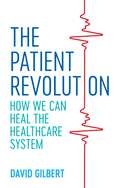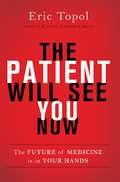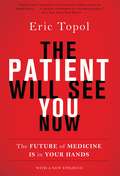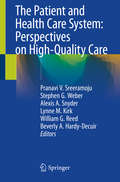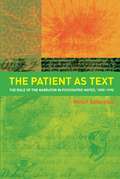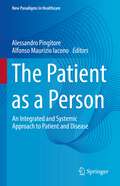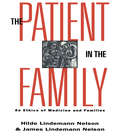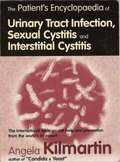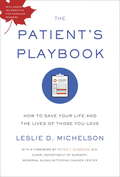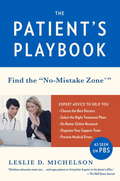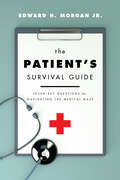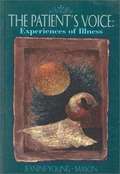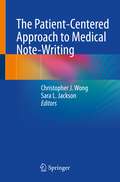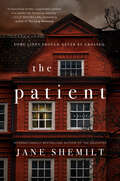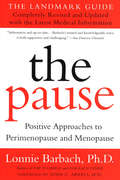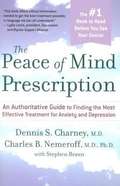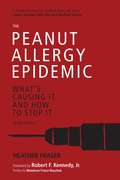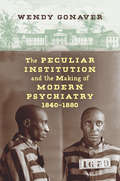- Table View
- List View
The Patient Revolution: How We Can Heal the Healthcare System
by David GilbertThe NHS is in crisis - it's in record demand, and care services are at breaking point - but what if the solution to rescuing the NHS is in the hands of the patients themselves?In this refreshingly positive and remarkable book, David Gilbert shares the powerful real-life stories of 'patient leaders' - ordinary people affected by life-changing illnesses, disabilities, or conditions, who have all gone back into the fray to help change the healthcare system in necessary and inspiring ways. Charting their diverse journeys - from managing to live with their condition, and their motivation to change the status quo, right through to their successes in improving approaches to health and social care - these moving and courageous stories aim to motivate others to take back control and showcase the pivotal importance of patients as genuine decision-making leaders.Filled with hard-won wisdom and everyday heroism, The Patient Revolution challenges current discourse and sets out an empowering vision of how patient leaders can change the future of healthcare.
The Patient Will See You Now
by Eric TopolIn The Patient Will See You Now, Eric Topol, one of the nation’s top physicians, examines what he calls medicine’s "Gutenberg moment. ” Much as the printing press liberated knowledge from the control of an elite class, new technology-from the smartphone to machine learning-is poised to democratize medicine. In this new era, patients will control their data and be emancipated from a paternalistic medical regime in which "the doctor knows best. ” Mobile phones, apps, and attachments will literally put the lab and the ICU in our pockets. Computers will replace physicians for many diagnostic tasks, and enormous data sets will give us new means to attack conditions that have long been incurable. In spite of these benefits, the path forward will be complicated: some in the medical establishment will resist these changes, and digitized medicine will raise serious issues surrounding privacy. Nevertheless, the result-better, cheaper, and more humane health care for all-will be worth it. The Patient Will See You Now is essential reading for anyone who thinks they deserve better health care. That is, for all of us.
The Patient Will See You Now
by Eric TopolA trip to the doctor is almost a guarantee of misery. You'll make an appointment months in advance. You'll probably wait for several hours until you hear "the doctor will see you now"--but only for fifteen minutes! Then you'll wait even longer for lab tests, the results of which you'll likely never see, unless they indicate further (and more invasive) tests, most of which will probably prove unnecessary (much like physicals themselves). And your bill will be astronomical. In The Patient Will See You Now, Eric Topol, one of the nation’s top physicians, shows why medicine does not have to be that way. Instead, you could use your smartphone to get rapid test results from one drop of blood, monitor your vital signs both day and night, and use an artificially intelligent algorithm to receive a diagnosis without having to see a doctor, all at a small fraction of the cost imposed by our modern healthcare system. The change is powered by what Topol calls medicine's "Gutenberg moment. " Much as the printing press took learning out of the hands of a priestly class, the mobile internet is doing the same for medicine, giving us unprecedented control over our healthcare. With smartphones in hand, we are no longer beholden to an impersonal and paternalistic system in which "doctor knows best. " Medicine has been digitized, Topol argues; now it will be democratized. Computers will replace physicians for many diagnostic tasks, citizen science will give rise to citizen medicine, and enormous data sets will give us new means to attack conditions that have long been incurable. Massive, open, online medicine, where diagnostics are done by Facebook-like comparisons of medical profiles, will enable real-time, real-world research on massive populations. There's no doubt the path forward will be complicated: the medical establishment will resist these changes, and digitized medicine inevitably raises serious issues surrounding privacy. Nevertheless, the result--better, cheaper, and more human health care--will be worth it. Provocative and engrossing, The Patient Will See You Now is essential reading for anyone who thinks they deserve better health care. That is, for all of us.
The Patient Will See You Now: The Future of Medicine Is in Your Hands
by Eric Topol"[Topol is] one of medicine's most innovative thinkers about the digital future.... [A] valuable contribution to a fascinating subject."--New York Times Book ReviewA trip to the doctor is almost a guarantee of misery. You'll make an appointment months in advance. You'll probably wait for several hours until you hear "the doctor will see you now"-but only for fifteen minutes! Then you'll wait even longer for lab tests, the results of which you'll likely never see, unless they indicate further (and more invasive) tests, most of which will probably prove unnecessary (much like physicals themselves). And your bill will be astronomical.In The Patient Will See You Now, Eric Topol, one of the nation's top physicians, shows why medicine does not have to be that way. Instead, you could use your smartphone to get rapid test results from one drop of blood, monitor your vital signs both day and night, and use an artificially intelligent algorithm to receive a diagnosis without having to see a doctor, all at a small fraction of the cost imposed by our modern healthcare system.The change is powered by what Topol calls medicine's "Gutenberg moment." Much as the printing press took learning out of the hands of a priestly class, the mobile internet is doing the same for medicine, giving us unprecedented control over our healthcare. With smartphones in hand, we are no longer beholden to an impersonal and paternalistic system in which "doctor knows best." Medicine has been digitized, Topol argues; now it will be democratized. Computers will replace physicians for many diagnostic tasks, citizen science will give rise to citizen medicine, and enormous data sets will give us new means to attack conditions that have long been incurable. Massive, open, online medicine, where diagnostics are done by Facebook-like comparisons of medical profiles, will enable real-time, real-world research on massive populations. There's no doubt the path forward will be complicated: the medical establishment will resist these changes, and digitized medicine inevitably raises serious issues surrounding privacy. Nevertheless, the result-better, cheaper, and more human health care-will be worth it.Provocative and engrossing, The Patient Will See You Now is essential reading for anyone who thinks they deserve better health care. That is, for all of us.
The Patient and Health Care System: Perspectives on High-Quality Care
by Pranavi V. Sreeramoju Stephen G. Weber Alexis A. Snyder Lynne M. Kirk William G. Reed Beverly A. Hardy-DecuirThis book focuses on the interface between the patient and the healthcare system as the entryway to high-quality care and improved outcomes. Unlike other texts, this book puts the patient back in the center of care while integrating the various practices and challenges. Written by interdisciplinary experts, the book begins by evaluating the entire quality landscape before giving voice to all parties involved, including physicians, nurses, administrators, patients, and families. The text then focuses on how to develop a structure that meets needs of all of these groups, effectively addressing common threats to positive outcomes and patient satisfaction. The text tackles the most common challenges clinicians face in a hospital setting, including infection prevention, medication error and stewardship that may jeopardize recovery, complex care, and employee-patient engagement.The Patient and Healthcare System: Perspectives on High-Quality Care is an excellent resource for physicians across broad specialties, nurses, hospital administrators, social workers, patient caregivers and all healthcare professionals concerned with infection prevention, quality and safety of care delivery, and patient satisfaction.
The Patient as Text: the Role of the Narrator in Psychiatric Notes, 1890-1990
by Petter AaslestadA commonly-held model of the doctor-patient relationship casts it as a subject/object relationship: broadly the patient is a 'text', and the doctor the reader or interpreter of that text. However, recent critical models preset notions of text and reader as complex and unstable, and the relationship of doctor and patient as similarly complicated. Explorations of psychiatry and 'madness' by critics such as Michel Foucault present a further background of complex ideological change. In The Patient as Text, Petter Aaslestad explores selections from over a century of psychiatric notes from Gaustad Hospital, Norway against this critical background, exploring the impact of ideological and medical changes surrounding the psychiatric clinical relationship and psychiatric professionals as constructors of narratives. This book will be of interest to researchers in the medical humanities, psychiatric practitioners, and those with an interest in medical history and critical theory.
The Patient as a Person: An Integrated and Systemic Approach to Patient and Disease (New Paradigms in Healthcare)
by Alfonso Maurizio Iacono Alessandro PingitoreIn the current era, evidence-based medicine and various supporting technologies dominate everyday clinical practice, according to a disease-centred, as opposed to patient-centred, approach. They have obviously improved the clinical management of diseases and it is therefore unreasonable to think of a medicine in which they are not considered fundamental. In fact, the strength of the new medicine should be to adapt scientific knowledge to a specific clinical case. This book therefore looks at the prospect of a new 'person' centred medicine, which stands alongside the 'disease' and 'patient' centred medicine, which pays special attention to the subjectivity of scientific knowledge and the relationship between doctor and patient. It is important to emphasise that this book is written by several hands, i.e. by experts from different fields, doctors, philosophers, architects, sociologists, art critics, physicists and engineers. This is with the intention of providing as broad a perspective as possible on the doctor-patient relationship. Due to its translational and multicultural approach to the subject, the book will be of interest to a wide readership, from medical experts to students, psychologists, philosophers and institutional actors.
The Patient in the Family: An Ethics of Medicine and Families (Reflective Bioethics)
by James Lindemann Nelson Hilde Lindemann NelsonThe Patient in the Family diagnoses the ways in which the worlds of home and hospital misunderstand each other. The authors explore how medicine, through its new reproductive technologies, is altering the structure of families, how families can participate more fully in medical decision-making, and how to understand the impact on families when medical advances extend life but not vitality.
The Patient's Encyclopaedia of Urinary Tract Infection, Sexual Cystitis and Interstitial Cystitis
by Angela KilmartinThe Patient's Encyclopaedia of Urinary Tract Infection contains three sections all packed with vital prevention and self help based on medical facts and simple daily tips. The hardcover now sells with a DVD to match. The newly-revised e-books in 2-option download formats will sell heavily world-wide. UTI's are a common, miserable, frightening, socially-devastating, recurrent female illness. Bacterial and Non-bacterial causes abound in the book. Comprehensively discussed are bacterial urinary infections, urethritis,urethral syndrome, cystitis, IC, bladder soreness,self-help,hygiene, diet, menopause, children, teens, sex, STD's, kidney infections, lifestyle, prevention,frequency, pain, incontinence, depression,females, babies,urology. And much more.
The Patient's Playbook
by Leslie D. MichelsonThe Patient's Playbook will change the way you manage your health and your family's health, from finding the right doctor to coordinating the best medical care. An expertly informed guide to the steps that everyone should take--even before illness strikes. The Patient's Playbook is a compelling narrative of personal stories that impart lessons and illuminate strategies for better, and even life-saving, medical decision-making. With clarity and as a call to action, Michelson presents the most effective approach to getting the best from a broken system: sourcing excellent doctors, choosing the right treatment protocols in the "no mistake zone," researching with precision, and structuring the ideal support team. Leslie D. Michelson has devoted his life's work to helping people access the best quality medical care--serving as an expert navigator for hundreds of clients. As the former head of the Prostate Cancer Foundation and the CEO of Private Health Management he has dedicated his life's work to helping individuals find the courage and confidence to get what they need in a challenging health system.
The Patient's Playbook
by Leslie D. MichelsonToo many Americans die each year as a result of preventable medical error--mistakes, complications, and misdiagnoses. And many more of us are not receiving the best care possible, even though it's readily available and we're entitled to it. The key is knowing how to access it. The Patient's Playbook is a call to action. It will change the way you manage your health and the health of your family, and it will show you how to choose the right doctor, coordinate the best care, and get to the No-Mistake Zone in medical decision making. Leslie D. Michelson has devoted his life's work to helping people achieve superior medical outcomes at every stage of their lives. Michelson presents real-life stories that impart lessons and illuminate his easy-to-follow strategies for navigating complex situations and cases. The Patient's Playbook is an essential guide to the most effective techniques for getting the best from a broken system: sourcing excellent physicians, selecting the right treatment protocols, researching with precision, and structuring the ideal support team. Along the way you will learn: Why having the right primary care physician will change your lifeThree things you can do right now to be better prepared when illness strikesThe ten must-ask questions at the end of a hospital stayHow to protect yourself from unnecessary and dangerous treatmentsWays to avoid the four most common mistakes in the first twenty-four hours of a medical emergency This book will enable you to become a smarter health care consumer--and to replace anxiety with confidence.From the Hardcover edition.
The Patient's Playbook: How to Save Your Life and the Lives of Those You Love
by Leslie D. MichelsonToo many Americans die each year as a result of preventable medical error--mistakes, complications, and misdiagnoses. And many more of us are not receiving the best care possible, even though it's readily available and we're entitled to it. The key is knowing how to access it. The Patient's Playbook is a call to action. It will change the way you manage your health and the health of your family, and it will show you how to choose the right doctor, coordinate the best care, and get to the No-Mistake Zone in medical decision making. Leslie D. Michelson has devoted his life's work to helping people achieve superior medical outcomes at every stage of their lives. Michelson presents real-life stories that impart lessons and illuminate his easy-to-follow strategies for navigating complex situations and cases. The Patient's Playbook is an essential guide to the most effective techniques for getting the best from a broken system: sourcing excellent physicians, selecting the right treatment protocols, researching with precision, and structuring the ideal support team. Along the way you will learn: Why having the right primary care physician will change your lifeThree things you can do right now to be better prepared when illness strikesThe ten must-ask questions at the end of a hospital stayHow to protect yourself from unnecessary and dangerous treatmentsWays to avoid the four most common mistakes in the first twenty-four hours of a medical emergency This book will enable you to become a smarter health care consumer--and to replace anxiety with confidence.From the Hardcover edition.
The Patient's Survival Guide: Seven Key Questions for Navigating the Medical Maze
by Edward H Morgan Jr.In the US medical environment where medical mistakes, over-diagnosis, and over-treatment have become the third leading cause of death, leadership consultant and long-time charity CEO Edward Morgan argues that protecting yourself with medical wisdom can add 10-15 years to your life.We're a nation on meds, where 60% of adults are now diagnosed with some chronic condition. We're listening to unwise advice and becoming permanent patients.Longevity is declining in America, even though medical costs in the US are twice that of other developed nations. Don't get caught in medical misadventures that escalate into permanent conditions, screenings that cascade into fear-driven decisions, prescriptions that simply suppress symptoms, or worst of all, end up dying in an ICU in the vain hope for a few more days.Smart is not the same as wise. Medical wisdom and discernment will extend your life. Taking today's aggressive, profit-driven advice will quite possibly shorten it. Living to see your grandchildren grow up is your responsibility, not your doctor's. This is a must read for anyone already feeling like a patient for life. With courage and wisdom you can become a well person again and live out your full lifespan.
The Patient's Voice: Experiences of Illness
by Jeanine Young-MasonDo you need to add caring to your course? Do your students need to become more aware of the process patients and families go through as they adapt to an illness or death? Sixteen contemporary autobiographical case studies written by children and adults who have experienced psychiatric and physical illnesses are contained in this unique text. Each case study begins with a brief description of the patient's clinical situation. Chapters are followed by points for discussion and study questions to further direct the exploration of the accounts and enhance students' critical thinking skills.
The Patient-Centered Approach to Medical Note-Writing
by Christopher J. Wong Sara L. JacksonPatients are increasingly accessing their own electronic health record, ushering medical chart notes out of the cloistered purview of clinicians and into the age of transparency. With the recognition that patients are reading what is written about them, there is a need for a comprehensive reference on best practices for writing medical notes in this new era. The Patient-Centered Approach to Medical Note-Writing covers important topics including stigmatizing language, the electronic health record, the different parts of a typical medical note, mental health, substance use, difficult encounters, and how to address electronic communication such as test results and patient messages. This book serves as a vital reference for students, residents, fellows and practicing clinicians.
The Patient: A Novel
by Jane ShemiltA shocking and twisty novel of psychological suspense about a boundary-breaking love affair between a doctor and her patient, by Jane Shemilt, Edgar-nominated, #1 international bestselling author of The Daughter. What price would you pay for falling in love?Rachel is a respected doctor who lives in a picturesque and affluent English village where her husband Nathan teaches at an elite private school. Competent, unflappable, and nearing 50, Rachel has everything in her life firmly in her control, even if some of its early luster has worn off. But one day a new patient arrives at her practice for emergency treatment. Luc is a French painter married to a wealthy American woman who’s just bought and restored a historic home on the edge of Rachel’s posh neighborhood. The couple has only recently arrived, but Luc is struggling with a mental disorder, and so he goes to the nearest clinic…to Rachel.Their attraction is instant, and as Rachel’s sense of ethics wars with newly awakened passion, the affair blinds her to everything else happening around her. A longtime patient appears to be following her every movement, turning up unexpectedly wherever she goes. Her somewhat estranged adult daughter Lizzie is hiding a secret—or at least, hiding it from Rachel. Nathan has grown sour and cold as well—or is that merely Rachel’s guilty conscience weighing on her? But when one of her colleagues winds up murdered and Luc is arrested for the crime, everything Rachel didn’t know about her life explodes into the open—along with her affair with her patient—a disgrace and scandal that will have consequences no one could have predicted.
The Pause (Revised Edition): The Landmark Guide
by Lonnie BarbachSince its original publication in 1993, The Pause has become known as the authoritative guide to menopause--a previously overlooked topic of great importance to women. The significant amount of new research on menopause and perimenopause amassed in recent years has led bestselling author Lonnie Barbach to completely revise and update this groundbreaking classic. Important additions include eight entirely new sections on topics such as SERMs (selective estrogen receptor modulators), phytoestrogens, and the impact of menopause on the female immune system. This additional research is combined with new information about menopause and mood, weight gain during menopausal transition, breast cancer survivors taking estrogen, the positive effect of estrogen on dementia and Alzheimer's, and new alternatives to traditional HRT (hormone replacement therapy) for managing hot flashes, improving bone density, and assisting breast cancer survivors. All together, the latest edition of The Pause is a must-have resource for any woman facing the "next third" of her life.
The Peace of Mind Prescription
by Dennis S. CharneyThe Ultimate Guide to Identifying, Treating, and Overcoming Depression and Anxiety Two world-renowned psychiatrists have created a comprehensive and empowering guide to the science and treatment of anxiety and depression. At the heart of their message is the idea that treatment can and must be tailored to the individual and that armed with the right information, patients can get the support they need from their health-care providers. Practical and authoritative, The Peace of Mind Prescription has been unanimously praised as a valuable resource that offers hope to millions of sufferers. Dennis S. Charney, M. D. , is the Dean of Research and the Anne and Joel Ehrenkranz Professor in the departments of psychiatry, neuroscience, and pharmacology and biochemistry at the Mount Sinai School of Medicine. Charles B. Nemeroff, M. D. , Ph. D. , is the Reunette W. Harris Professor and chairman of the department of psychiatry and behavioral sciences at Emory University's School of Medicine.
The Peanut Allergy Epidemic, Third Edition: What's Causing It and How to Stop It
by Heather Fraser Robert F. Jr.Essential reading for every parent of a child with peanut allergies-third edition with a foreword by Robert F. Kennedy, Jr.Why is the peanut allergy an epidemic that only seems to be found in western cultures? More than four million people in the United States alone are affected by peanut allergies, while there are few reported cases in India, a country where peanut is the primary ingredient in many baby food products. Where did this allergy come from, and does medicine play any kind of role in the phenomenon? After her own child had an anaphylactic reaction to peanut butter, historian Heather Fraser decided to discover the answers to these questions.In The Peanut Allergy Epidemic, Fraser delves into the history of this allergy, trying to understand why it largely develops in children and studying its relationship with social, medical, political, and economic factors. In an international overview of the subject, she compares the epidemic in the United States to sixteen other geographical locations; she finds that in addition to the United States in countries such as Canada, the United Kingdom, Australia, and Sweden, there is a one in fifty chance that a child, especially a male, will develop a peanut allergy. Fraser also highlights alternative medicines and explores issues of vaccine safety and other food allergies.This third edition features a foreword from Robert F. Kennedy, Jr. and a new chapter on promising leads for cures to peanut allergies. The Peanut Allergy Epidemic is a must read for every parent, teacher, and health professional.
The Peculiar Institution and the Making of Modern Psychiatry, 1840–1880
by Wendy GonaverThough the origins of asylums can be traced to Europe, the systematic segregation of the mentally ill into specialized institutions occurred in the United States only after 1800, just as the struggle to end slavery took hold. In this book, Wendy Gonaver examines the relationship between these two historical developments, showing how slavery and ideas about race shaped early mental health treatment in the United States, especially in the South. She reveals these connections through the histories of two asylums in Virginia: the Eastern Lunatic Asylum in Williamsburg, the first in the nation; and the Central Lunatic Asylum in Petersburg, the first created specifically for African Americans. Eastern Lunatic Asylum was the only institution to accept both slaves and free blacks as patients and to employ slaves as attendants.Drawing from these institutions' untapped archives, Gonaver reveals how slavery influenced ideas about patient liberty, about the proper relationship between caregiver and patient, about what constituted healthy religious belief and unhealthy fanaticism, and about gender. This early form of psychiatric care acted as a precursor to public health policy for generations, and Gonaver's book fills an important gap in the historiography of mental health and race in the nineteenth century.
The Pediatric Anterior Cruciate Ligament
by Shital N. ParikhThis unique book fills the void in the existing literature related to the diagnosis and evaluation of pediatric ACL injuries and presents both current and emerging surgical techniques for pediatric ACL reconstruction. Once considered rare, these injuries are on the rise as children are increasingly active and engaged in high-impact sports. Historically, these injuries have been treated with benign neglect, but there is increasing evidence that non-operative treatment approaches can lead to recurrent instability, further injury to the meniscus or cartilage, and eventually joint degeneration. Opening with discussion of epidemiology, developmental anatomy, and assessment and radiography, this one-stop resource then presents conservative and surgical management strategies and algorithms, including ACL reconstruction without bone tunnels, use of epiphyseal tunnels, trans-physeal tunnels, or hybrid techniques. Special attention is given to the young female athlete, complications, prevention strategies, rehabilitation and return to play considerations. Bringing together the latest clinical evidence with the preferred techniques of experts in the field, The Pediatric Anterior Cruciate Ligament is a comprehensive and detailed analysis of the inherent problems in treating ACL injuries in the pediatric patient, useful for pediatric orthopedic surgeons, orthopedic sports medicine surgeons, primary care sports medicine physicians and other professionals working with the young athlete.
The Pediatric Cardiac Anesthesia Handbook
by Viviane G. Nasr James A. DiNardoA concise yet comprehensive overview of the anesthetic management of pediatric patients with congenital heart disease Designed for ease of use, The Pediatric Cardiac Anesthesia Handbook is divided into two parts: Part One covers the basic assessment of patients, including cardiovascular physiology, the pathophysiology of coronary heart disease, preoperative evaluation, intraoperative management, and interpretation of cardiac catheterization data. Part Two contains templated chapters that address a variety of disorders, allowing easy reference to anatomical and physiological features, surgical therapies, anesthetic approach, and postoperative management. Now in its second edition, The Pediatric Cardiac Anesthesia Handbook contains new chapters on coagulation and blood management, echocardiography, risk scoring systems, and postoperative critical care management, as well as a completely revised chapter on mechanical circulatory support. Providing clear and reliable, this easily referable pocket-sized resource: Addresses the additional complexities of pediatric patients and the anesthetic considerations for non-cardiac surgery after heart and heart-lung transplantationProvides guidelines on specific lesions for the pediatric anesthesiologist caring for cardiac patients presenting for non-cardiac surgeryContains templated chapters that allow easy reference by members of the multidisciplinary team, such as cardiologists, cardiac intensivists, perfusionists, and surgeonsFeatures high-quality illustrative echocardiographic images in every chapter and bulleted content designed for rapid reference Written by an expert author team at the world-renowned Boston Children’s Hospital, The Pediatric Cardiac Anesthesia Handbook is a must-have guide and study aid for anesthesiology and cardiac critical care trainees and practitioners who manage patients with congenital heart disease.
The Pediatric Cardiac Anesthesia Handbook
by James A. Dinardo Viviane G. NasrWritten by an expert author team at the renowned Boston Children's Hospital, USA, The Pediatric Cardiac Anesthesia Handbook provides a comprehensive yet concise overview of the anesthetic management of pediatric patients with congenital heart disease. This book is divided into two parts. The first part provides an introduction to the basic assessment of patients, including cardiovascular physiology, pathophysiology and the underlying concepts in coronary heart disease, preoperative evaluation, intraoperative management, and interpretation of cardiac catheterization data. The second part of the book addresses disorders and diseases in a templated manner covering the anatomical and physiological features, surgical therapies, anesthetic approach and postoperative management. Chapters on the heart and heart and lung transplantation consider the additional complexities of those patients and anesthetic considerations for non-cardiac surgery after heart transplantation. The anesthesiologist caring for patients with congenital heart disease faces a myriad of challenges in the perioperative management of these complex individuals. This book provides: A concise and easily referable guide ideal for use during anesthesiology residency training and fellowships. A templated chapter layout ideal for easy referral by wider members of the multidisciplinary team, such as cardiologists, cardiac intensivists, perfusionists, and surgeons. Helpful illustrations and a bulleted content for rapid reference. Guidelines on specific lesions for the pediatric anesthesiologist caring for cardiac patients presenting for non-cardiac surgery. This book is a valuable resource for all anesthesiology and cardiac critical care providers who manage patients with congenital heart disease, and an ideal study aid.
The Pediatric Foot and Ankle: Diagnosis and Management
by Michelle L. Butterworth John T. MarcouxThe Pediatric Foot and Ankle is a comprehensive overview of the current evaluation, diagnosis, and management strategies for various foot and ankle disorders in the pediatric patient. It begins with a general history and physical and radiographic exam of the child’s lower extremity to establish normal parameters. Specific disorders are then described in detail, including neurological abnormalities, congenital deformities, and traumatic episodes. Expert authors in each area not only provide their insight and experience for proper diagnosis and treatment, but also proffer available evidence-based medicine on the topic. Since there is currently very little available to the surgeon regarding pediatric foot and ankle surgery, this book is a comprehensive authority on the topic, providing both surgical pearls and evidence-based medicine.
The Pediatric Primer: A Medical Encyclopedia for Caring for Sick and Well Children
by Michael W SimonYour children are always on the move, and keeping up with the best treatment for their bumps and scrapes, fevers and colds, is a challenge for even the most experienced parents. This book is an essential resource for parents and grandparents of all skill
